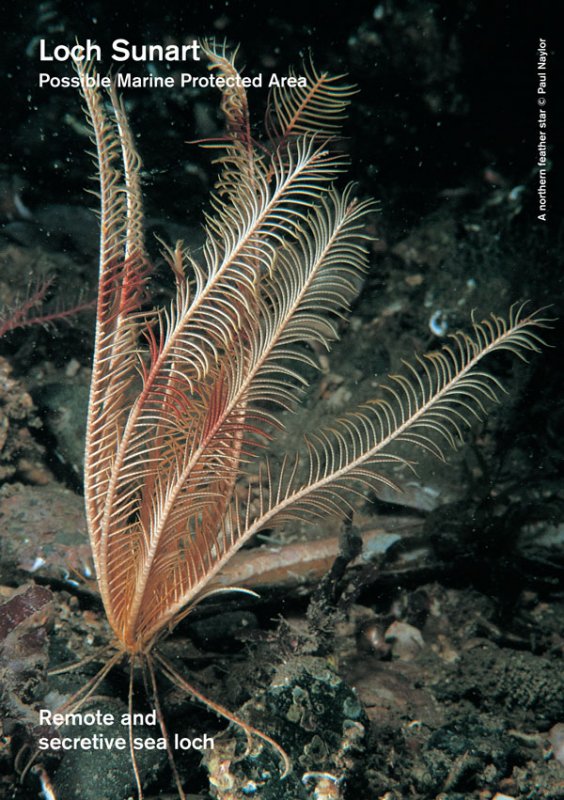Loch Sunart is a long narrow sea loch at the northern end of the Sound of Mull. Within the loch there are numerous small islands creating narrow channels through which the incoming and outgoing tide is squeezed. These fast flowing currents create the essential conditions for the development of extensive flame shell beds, the largest of which is found in the Laudale Narrows. [1]
Loch Sunart nature conservation MPA complements the existing Loch Sunart Special Area of Conservation (SAC).
This site now has fisheries management measures in place.
History of this MPA/SAC:
Read our response to the consultation on proposed management measures here:
Save Scottish Seas campaign members have assessed the Scottish Government’s MPA proposal for this site as part of its consultation response.We agree with the management advice for, and fully support the prohibition of mobile demersal
gear from, the benthic features of Loch Sunart SAC/MPA, namely reefs, flame shell beds, northern
featherstar and serpulid reefs. We suggest that Loch Sunart should have a site-wide prohibition on
mobile demersal gear, particularly given the presence of common skate sightings in the proposed
area at the mouth in which demersal fishing is permitted.Read our response to the consultation on site designation here:
Save Scottish Seas campaign members have assessed the Scottish Government’s MPA proposal for this site as part of its consultation response.
LINK support the designation of the Loch Sunart possible Nature Conservation MPA for the protection of flame shell beds; northern feather star aggregations on mixed substrata and serpulid aggregations. The bounday and area of the Loch Sunart possible MPA is fully supported. The area has already been declared SAC for the reefs habitats and management will need to refer to, and align with, the objectives of the SAC.
Until a clearer understanding of historic pressures and current extent is arrived it, we would conclude that the status of the features in their historic context is uncertain and should not default to ‘conserve’.Management Options:
We support advice to remove damaging pressures from the proposed protected features. The management options to regulate and minimise impact to these benthic communities are supported. We support and encourage designation of zones prohibiting all forms of disturbance by mechanical and static fishing gear, anchors, moorings, diver-operated hydraulic methods and expansion of new aquaculture ventures, to ensure the full known extent of these sensitive communities are fully protected from disturbance and, with a suitable buffer zone around them, have opportunity for future enhancement.Existing aquaculture ventures will need to ensure they are compliant with updated or revised Environmental Management Systems to ensure operations minimise local and diffuse cumulative impacts, particularly with respect to water quality, erosion, sedimentation and disease.
In the absence of detailed information relating to the impacts of aquaculture on proposed protected features within an MPA it is imperative that the precautionary approach be applied. Discussions with finfish farming interests cannot be used as a proxy for specific, detailed information and where doubt exists management measures must be precautionary.Socioeconomic Assessment:
LINK acknowledges the important contribution of the Marine Conservation Society in bringing this possible MPA to the consultation stage.
This contribution is an excellent demonstration of the high value that communities, both of place and of interest, put on the integrity of the marine environment. It also points to the existence of the non-use value of MPAs that has been largely omitted from the economic assessments.
The socioeconomic impact data presented in the BRIA indicates the small costs associated with designation and restriction of damaging activities will be outweighed by the medium to long term benefit of protecting the ecological integrity of the possible MPA so it can continue to provide ecosystem services to Scotland’s inshore waters. The potential value of the Loch Sunart possible MPA to divers and sea anglers has been estimated at £7.2 to £15.2million based on willingness-to-pay measures (Kenter et al., 2013) . Kenter et al. also found important emotional and well-being benefits associated with the Loch Sunart possible MPA, with divers and anglers responding to a questionnaire scoring >4 (out of a maximum score of 5) for engagement, identify, therapeutic, transformative, spiritual and social wellbeing indicator values.Harbour porpoise are known to use this site and under Guideline 1b of the selection criteria for PMFs on the OSPAR T&D list should be protected in the MPA and considered in the management and the socioeconomic assessment, as well as consideration of designation as part of the Natura 2000 SAC network
Find out more about the Loch Sunart MPA on the Scottish Natural Heritage website, and the Loch Sunart SAC on the Joint Nature Conservation Committee website.
[1] Loch Sunart MPA site summary document, SNH

